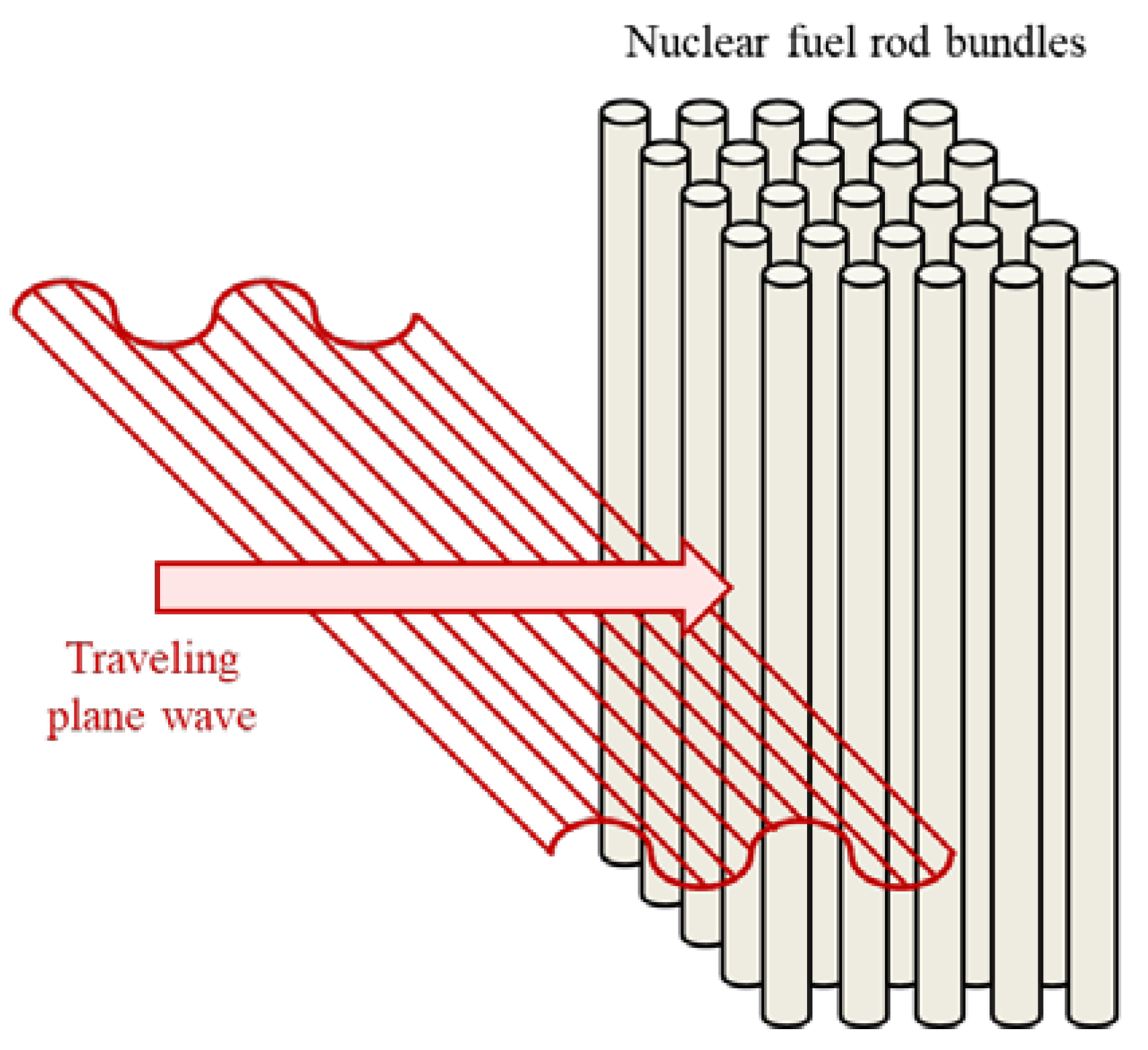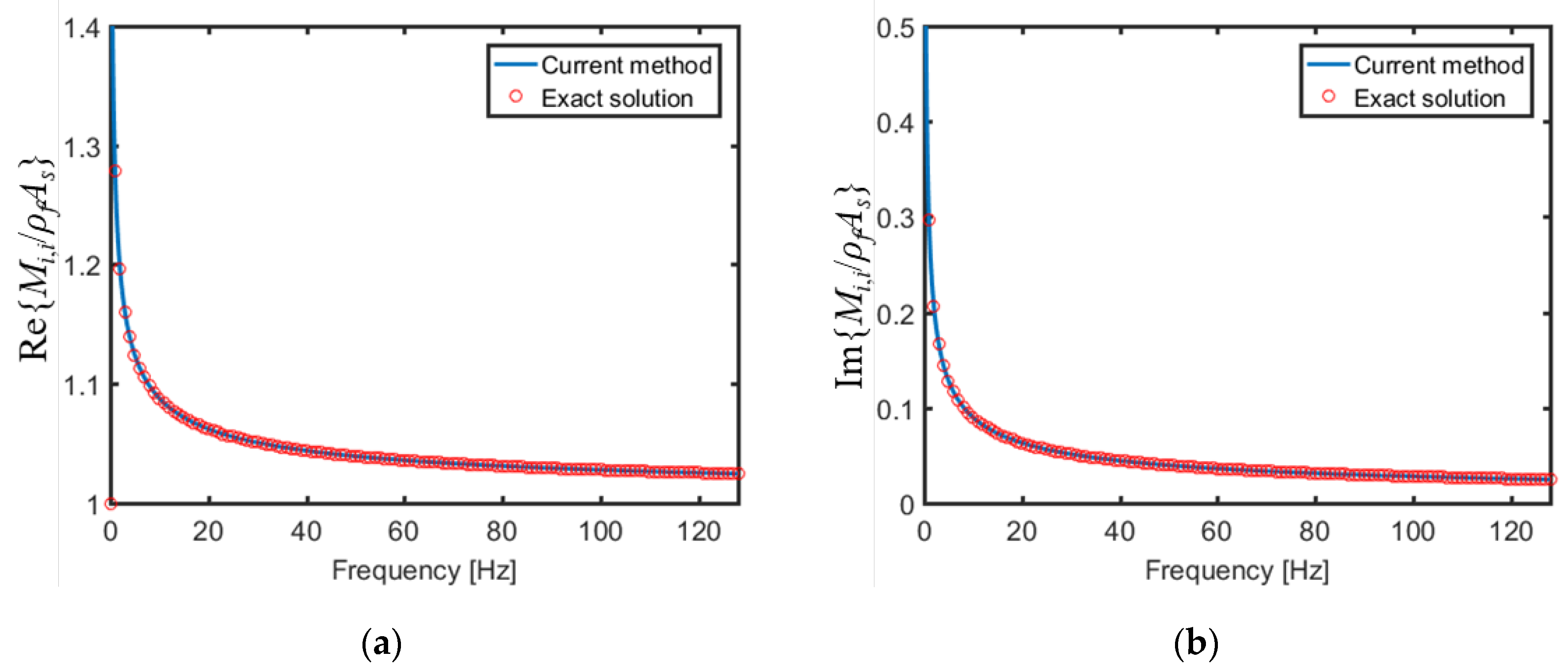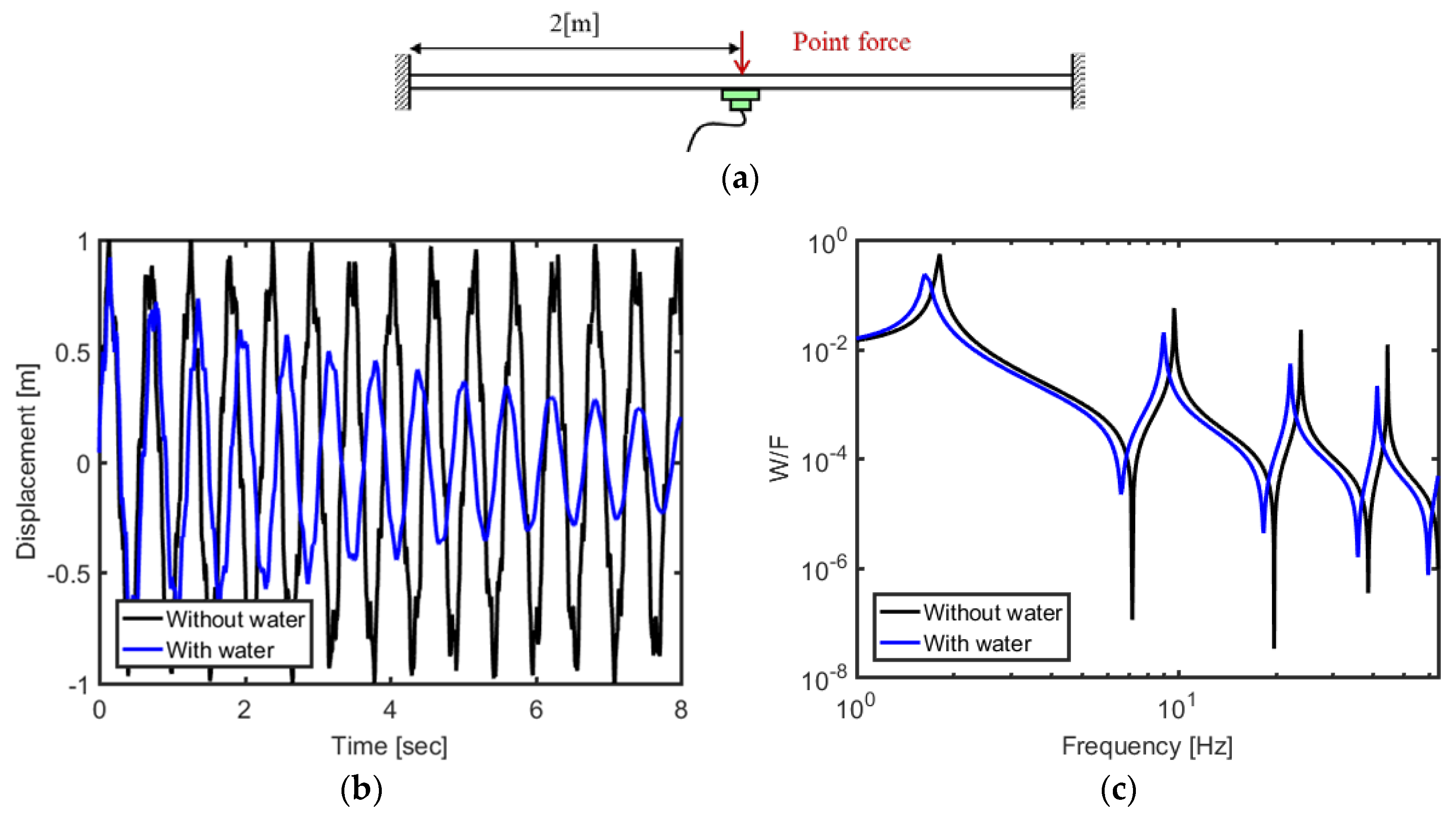Flexural Vibration Analysis of Nuclear Fuel Rod Bundles Interacting with Surrounding Fluid Subjected to Pressure Wave
Abstract
:Featured Application
Abstract
1. Introduction
2. Equation of Motion for Nuclear Rod Bundles Surrounded by Viscous Fluid
2.1. Flexural Vibration of Nuclear Rod Bundles
2.2. Flexural Vibration of Nuclear Rod Bundles
2.3. External Force Induced by the Pressure Wave
2.4. Numerical Model of Nuclear Rod Bundles
3. Results and Discussion
4. Conclusions
Author Contributions
Funding
Conflicts of Interest
References
- Païdoussis, M.P. Fluid–Structure Interactions: Slender Structures and Axial Flow, 2nd ed.; Academic Press: Oxford, UK, 2014; Volume 1. [Google Scholar]
- Doaré, O.; Langre, E. Local and global instability of fluid–conveying pipes on elastic foundations. J. Fluids Struct. 2002, 16, 1–14. [Google Scholar] [CrossRef]
- Païdoussis, M.P.; Issid, N. Dynamic stability of pipes conveying fluid. J. Sound Vib. 1974, 33, 267–294. [Google Scholar] [CrossRef]
- Kim, T.; Je, S.; Chang, Y. Fluid−elastic instability evaluation for reactor vessel internals with structural interaction. Prog. Nucl. Energy 2019, 110, 41–50. [Google Scholar] [CrossRef]
- Lu, J.; Yuan, S.; Parameswaran, S.; Yuan, J.; Ren, X.; Si, Q. Investigation on the vibration and flow instabilities induced by cavitation in a centrifugal pump. Adv. Mech. Eng. 2017, 9, 1–11. [Google Scholar] [CrossRef]
- Ferrari, G.; Balasubramanian, P.; Guisquet, S.; Piccagli, L.; Karazis, K.; Painter, B.; Amabili, M. Non linear vibrations of nuclear fuel rods. Nucl. Eng. Des. 2018, 338, 269–283. [Google Scholar] [CrossRef]
- Choi, M.; Kang, H.; Yoon, K.; Song, K. Vibration analysis of a dummy fuel rod continuously supported by spacer grids. Nucl. Eng. Des. 2004, 232, 185–196. [Google Scholar] [CrossRef]
- Lee, Y.; Kim, H. Effect of spring shapes on the variation of loading conditions and the wear behavior of the nuclear fuel rod during fretting wear tests. Wear 2007, 263, 451–457. [Google Scholar] [CrossRef]
- Wiggert, D.C.; Tijsseling, A.S. Fluid transients and fluid–structure interaction in flexible liquid–filled piping. Appl. Mech. Rev. 2001, 54, 455–481. [Google Scholar] [CrossRef]
- Sreejith, B.; Jayaraj, K.; Ganesan, N.; Padmanabhan, C.; Chellapandi, P.; Selvaraj, P. Finite element analysis of fluid–structure interaction in pipeline systems. Nucl. Eng. Des. 2004, 227, 313–322. [Google Scholar] [CrossRef]
- Bazilevs, Y.; Calo, V.M.; Zhang, Y.; Hughes, T.J.R. Isogeometric fluid–structure interaction analysis with applications to arterial blood flow. Comput. Mech. 2006, 38, 310–322. [Google Scholar] [CrossRef]
- Strang, G. Computational Science and Engineering; Wellesley–Cambridge Press: Wellesley, MA, USA, 2007. [Google Scholar]
- Cook, R.D. Concepts and Applications of Finite Element Analysis; John Wiley and Sons: New York, NY, USA, 2007. [Google Scholar]
- Lee, U. Spectral Element Method in Structural Dynamics; John Wiley and Sons: Singapore, 2009. [Google Scholar]
- Lee, U.; Oh, H. The spectral element model for pipelines conveying internal steady flow. Eng. Struct. 2003, 25, 1045–1055. [Google Scholar] [CrossRef]
- Lee, U.; Park, J. Spectral element modelling and analysis of a pipeline conveying internal unsteady fluid. J. Fluids Struct. 2006, 22, 273–292. [Google Scholar] [CrossRef]
- Lee, U.; Jang, I. Spectral element modeling and analysis of the blood flows in viscoelastic vessels. Appl. Math. Comput. 2012, 218, 7295–7307. [Google Scholar] [CrossRef]
- Kjolsing, E.J.; Todd, M.D. Frequency response of a fixed–fixed pipe immersed in viscous fluids, conveying internal steady flow. J. Pet. Sci. Eng. 2015, 134, 247–256. [Google Scholar] [CrossRef]
- Kjolsing, E.J.; Todd, M.D. Damping of a fluid–conveying pipe surrounded by a viscous annulus fluid. J. Sound Vib. 2017, 394, 575–592. [Google Scholar] [CrossRef]
- Wu, J.M.; Liang, H.Y.; Zhu, F.J.; Lei, J. CFD analysis of the impact of a novel spacer grid with longitudinal vortex generators on the sub-channel flow and heat transfer of a rod bundle. Nucl. Eng. Des. 2017, 324, 78–92. [Google Scholar] [CrossRef]
- Mohany, A.; Hassan, M. Modelling of fuel bundle vibration and the associated fretting wear in a CANDU fuel channel. Nucl. Eng. Des. 2013, 264, 214–222. [Google Scholar] [CrossRef]
- Tian, W.X.; Zhang, K.; Hou, Y.D.; Zhang, Y.P.; Qiu, S.Z.; Su, G.H. Hydrodynamics of two-phase flow in a rod bundle under cross-flow condition. Ann. Nucl. Eng. 2016, 91, 206–214. [Google Scholar] [CrossRef]
- Cho, S.; Yang, W.; Lee, S.; Park, J. Flexural wave cloaking via embedded cylinders with systematically varying thicknesses. J. Acoust. Soc. Am. 2016, 139, 3320–3324. [Google Scholar] [CrossRef] [PubMed]
- Sader, J.E. Frequency response of cantilever beams immersed in viscous fluids with applications to the atomic force microscope. J. Appl. Phys. 1998, 84, 64. [Google Scholar] [CrossRef] [Green Version]











© 2020 by the authors. Licensee MDPI, Basel, Switzerland. This article is an open access article distributed under the terms and conditions of the Creative Commons Attribution (CC BY) license (http://creativecommons.org/licenses/by/4.0/).
Share and Cite
Yang, W.; Kang, H.; Park, J. Flexural Vibration Analysis of Nuclear Fuel Rod Bundles Interacting with Surrounding Fluid Subjected to Pressure Wave. Appl. Sci. 2020, 10, 2282. https://doi.org/10.3390/app10072282
Yang W, Kang H, Park J. Flexural Vibration Analysis of Nuclear Fuel Rod Bundles Interacting with Surrounding Fluid Subjected to Pressure Wave. Applied Sciences. 2020; 10(7):2282. https://doi.org/10.3390/app10072282
Chicago/Turabian StyleYang, Wonseok, Heungseok Kang, and Junhong Park. 2020. "Flexural Vibration Analysis of Nuclear Fuel Rod Bundles Interacting with Surrounding Fluid Subjected to Pressure Wave" Applied Sciences 10, no. 7: 2282. https://doi.org/10.3390/app10072282




